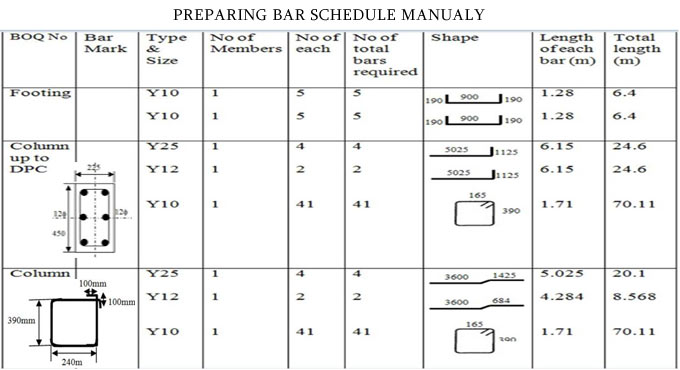NEWS | SOFTWARE | SHEET
Creating Bar Schedule manually
Reinforced concrete is the highly generally utilized structural component in building engineering. Even though concrete is persistent in obstructing stress (compressive stress), it’s flexible in tension. For this reason, to support strong (tensional) pressures (stresses), steel is required in concrete.
The support in concrete could be simple rods or bars turned and linked to a granted schedule along with supports. The suggested bars’ diameters utilized at place (site) were R6, Y12, Y10, Y20, Y16 and Y25.
Steel is provided in 2 fundamental sorts:
A. Tor steel (460 N/mm2)
B. Mild steel (250 N/mm2)
Bar code: Reinforcement implication in illustrations: There’s a principle to illustrate support (reinforcement) in illustrations (drawings),
5Y10 – 001 – 150: This indicates 5 quantity (number) of Tor steel, 10 millimetres diameter, bar mark / bar number 001, at 150 millimetre Corrosion Resistant Steel.
Bar form (location) can change in such a way, Slab details –
T1: Top external layer
T2: Top subsequent (second) layer
B1: Base (bottom) external layer
B2: Base (Bottom) subsequent (second) layer
Bars cutting and turning: There’s a balance (steel yard) in the place for keeping, cutting and turning of bars. Reinforcement bars are parted into needed dimensions (lengths) and turned into needed forms displayed on the bar schedule if customarily or through machines.
In customarily processes, labourers utilized the bar bending bench on which persistent nails are set and Galvanized Iron pipes with appropriate dimensions to turn the bars. This is utilized for slighter diameter bars. For turning of greater diameter bars, bar bending machine is utilized. Subsequent to turning, total reinforcement bars were gathered and counted as per the bar mark in order that steel fixers are not going to meet any issue while setting them.
Set up bar schedule (significant points)
Support Bar Schedule: Support (Reinforcement) Bar Schedule is set in a conventional way.
The bar bending schedule must be set and it must be offered to the steel bar balance (steel yard) and to part and turn the bars for aims, as bar bending schedule is in the illustrations which can be comfortably comprehended.
It includes all the info required for steel fabrication. These particulars are bar sort and dimension, bar mark, units’ quantity, bar length, form code, length connecting supports (beam, column, base), etc.
Benefits of the bar schedule:
• By setting up a bar schedule, and organizing them as per the dimensions, it’ll result in a cost-effective bar cutting, minimize the bar cutting wastes.
• It’s simple to administer the support supply needed for known time period.
• It’ll assist to Representative factor or fraction fabrication with construction.
Source: www.basiccivilengineering.com


